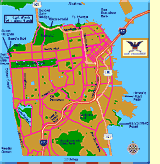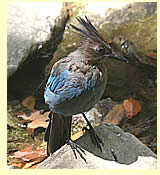





BIRDING IN SAN FRANCISCO

|
The Presidio and Golden Gate Park together provide over 3000 acres of open space and public access. Situated at the south end of the Golden Gate and along the Pacific flyway, San Francisco has several good migrant traps for exciting fall birding. Also its location at the edge of the continent makes it a likely place for a handful of eastern vagrants every year. Click here for a list of likely target species for visiting birders which should help you know when, where and how to look. Before or during any visit, acquaint yourself regularly with the Northern California Birdbox (rare bird alert) whose phone number is 415-681-7422. It is constantly updated by the area's birders, and not merely a weekly summary. Here are some hints about local conditions. San Francisco's rainy season is November through March. While it rarely gets below 40-degrees Fahrenheit, winter storms can be wet, windy and unpredictable. Any time of the year the coastal portions of San Francisco can get ocean fog and wind. Do not expect to bird the Cliff House in shorts and sandals, even in August. "Hot" in San Francisco means 75-degrees Fahrenheit. If it gets to 80, the local populace complains about the heat. Homes here are not air conditioned, except by Mother Nature. |
|
|
There are few natural hazards. Poison oak. Fleas. Blowing sand at Ocean Beach on windy days. If you come from a humid climate, know that San Francisco is dry from April to October. Drink plenty of water. You can get sun-burned even on a foggy day.
If you plan to bird the area from Fort Funston north to Land's End, try to start early if it's a clear day. By the time the sun is overhead the glare off the water can be a problem. The Golden Gate Audubon Society has frequent free bird walks. They are a good way to get many of the local specialties. From September through April a good day in the field in San Francisco should net over a 100 species. The big day record for San Francisco (not counting any offshore birding) is over 120. The San Francisco Christmas Bird Count produces over 160 species annually, but includes some rich habitat in neighboring San Mateo County. In April and May you can sometimes see streams of loons, ducks and shorebirds heading north past Fort Funston or the Cliff House. Any season the six miles of Pacific Ocean coastline can produce a surprising bird. Even dolphins or a whale. |
|
TOWHEE.NET: Harry Fuller, 820 NW 19th Street, McMinnville, OR 97128
website@towhee.net

 There are some urban hazards. Very expensive parking tickets. Towaway zones are to be respected if you are driving. Cars at Candlestick Point have been broken into. Don't bird there or Pier 98 alone. The other birding spots in San Francisco are as safe as you can be in an American city.
There are some urban hazards. Very expensive parking tickets. Towaway zones are to be respected if you are driving. Cars at Candlestick Point have been broken into. Don't bird there or Pier 98 alone. The other birding spots in San Francisco are as safe as you can be in an American city.